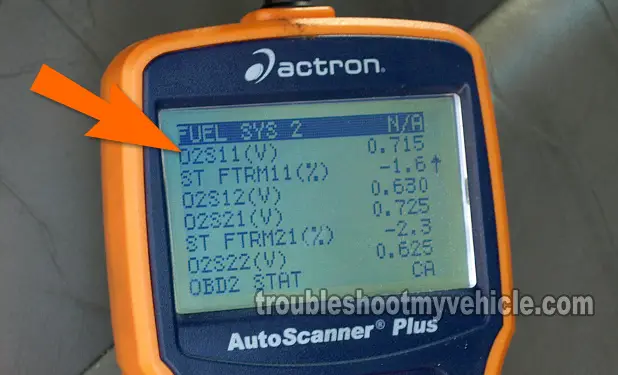
Troubleshooting the cause of a P0132 O2 Sensor Circuit High Voltage (Bank 1 Sensor 1) is not hard.
In this tutorial, I'm gonna' show you some of the basics you need to know about what DTC P0132 means and a step-by-step test of the upstream oxygen sensor.
Although this tutorial is geared toward a 3.9L, 5.2L, or 5.9L Dodge/Jeep pick up, van, or SUV; the info and test can be used on any 1996-2003 make or model.
Contents of this tutorial:
P0132 Basics You Need To Know
To get started, let's take a look at a few basic things about trouble code P0132. One of the most important things we need to know is that this code is referring to the performance of the upstream oxygen sensor. Here are the specifics:
LOCATION: This oxygen sensor is located before the catalytic converter and is known by several different names. The most common are:
- Upstream oxygen sensor.
- O2S11.
- Pre-catalytic converter oxygen sensor.
- Front O2 sensor.
Your specific Dodge/Jeep vehicle may have one or two upstream oxygen sensors. To help you in finding the correct oxygen sensor, here are some more specifics:
- Vehicles with 2 upstream oxygen sensors, a P0132 DTC is identifying the one that's on Bank 1. Bank 1 is the bank of cylinders that have cylinders 1, 3, 5, and 7 (5.2L and 5.9L V-8 engines) and 1, 3, and 5 (3.9L V-6 engines).
- Vehicles with only 1 upstream oxygen sensor, a P0132 DTC is identifying the only one that's before the catalytic converter.
DEFINITION: P0132 O2 Sensor Circuit High Voltage (Bank 1 Sensor 1) diagnostic trouble code (DTC) is telling you that:
- The upstream oxygen sensor, located before the catalytic converter, is producing and thus reporting an excessively high voltage to the PCM (Powertrain Control Module). This continuous voltage will be a value over 0.5 Volts (500 millivolts).
- This high voltage value is being seen by the PCM for more than 2 minutes.
- This continuous high voltage is usually around 0.9 Volts DC (900 millivolts), although it can be a voltage value between 0.5 to 1 Volt (500 to 1000 millivolts).
- Any continuous voltage above 0.5 Volts indicates a Rich condition but not always, since the O2 sensor can fail and produce the same result (although a Rich condition does not really exists)
- In a nutshell, a Rich condition simply refers to the fact that an excessive amount of fuel is being injected into the engine.
OPERATION: In a normally operating engine, the front (upstream) O2 sensors will produce a voltage that will constantly and rapidly change between 0.1 Volt to 0.9 Volts DC.
So, when a P0132 is lighting up the check engine light (CEL), the PCM is seeing a voltage that stays continually fixed somewhere above 0.5 Volts for more than 2 minutes.
PROBABLE CAUSES: Several things can cause a P0132 diagnostic trouble code, the most common causes of a P0132 DTC are:
- Bad oxygen sensor.
- This is probably the most common cause of a P0132 DTC (but not always).
- The oxygen sensor fails internally in such a way that it stays stuck producing a continuous voltage above 0.5 Volts (500 millivolts).
- A Rich condition due to a:
- High fuel pressure.
- Leaking fuel injectors.
- Bad fuel pressure regulator (this bad boy is part of the fuel pump assembly on Dodge/Jeep vehicles covered in this tutorial).
- EVAP canister vacuum hose leaking fuel into the intake manifold.
- A throttle position sensor (TPS) that is failing intermittently.
- PCM not getting the correct signal due to a short in the O2 sensor's wiring.
- This usually the end result of the O2 sensor's wiring or the engine wiring harness coming into contact with the exhaust pipe, exhaust manifold or a hard edge (usually on the engine) that causes wiring's insulation starts to melt.
- Bad PCM. This is extremely rare.
With this basic info we can now start troubleshooting the P0132 DTC, let's turn the page and get testing.
How To Diagnose Trouble Code P0132 O2 Sensor Circuit High Voltage (Bank 1 Sensor 1)
Troubleshooting a P0132 involves 2 basic things. First, you need to check that the upstream O2 sensor's wiring is not shorted to the exhaust pipe. This means checking that the oxygen sensor's wiring is not melted and stuck to the exhaust pipe.
NOTE: Check the oxygen sensor's wiring for shorts with the engine completely cold! The exhaust pipe, and especially the catalytic converter, stay very hot even after the engine has been shut down. Be careful and use common sense to avoid severe burns on your hands and/or arms while inspecting the upstream oxygen sensor's wiring!
Second, you need to confirm that the front (upstream) O2 sensor voltage is really producing an excessive high voltage with a scan tool. This scan tool has to have Live Data capability so you can see the actual voltage the oxygen sensor is producing/reporting (Don't have a scan tool? Need a scan tool? check out my recommendation: Actron CP9580 Scan Tool Review).
Don't worry, in the test steps below, I'll show you how to test the upstream oxygen sensor with a scan tool.
This is what you'll need to do:
- 1
Connect your scan tool to your car or mini-van and start the engine (Don't have a scan tool? Need a scan tool? check out my recommendation: Actron CP9580 Scan Tool Review).
Let the engine idle for at least 15 minutes before you start the test, to get the O2 sensor to activate. - 2
Now, on your scan tool (and once you're in Live Data mode), scroll down to the PID that's labeled O2S11. This PID is the one that will show you what the oxygen sensor is reporting in Volts DC.
- 3
Now, take a look at the voltage readings for O2S11.
These should be constantly moving between any number between 0.100 Volts and 0.900 Volts.
If the voltages are not moving between 0.100 and 0.900 Volts, don't worry about it just yet. Go on to the next step. - 4
With the engine running, start to disconnect a big vacuum hose while you observe your scan tool's display screen to get the air/fuel mixture to Lean out.
Note: I suggest removing the positive crankcase ventilation (PCV) hose to get the air/fuel mixture to lean out. See photo 2 of 2 in the image viewer.
What you're trying to accomplish, by unseating the PCV valve, is to produce a lean condition. By manually forcing a Lean condition, you and I can see if the upstream oxygen sensor will ‘see’ and report it to the PCM (which we'll be able to see on our scan tool, in Live Data mode of course). - 5
As ambient air starts to get sucked into the vacuum hose's port, you should see the voltage numbers of O2S11 immediately go down to about 0.100 Volts.
- 6
Reconnecting the vacuum hose and see if the O2 sensor's reading goes back to its previous activity.
Let's take a look at what your test results mean:
CASE 1: The upstream O2 sensor's voltage decreased to 0.1 Volt This confirms that the upstream oxygen sensor is OK and responding to the changes in the air/fuel mixture.
This also means that the high voltage the upstream O2 sensor is reporting is being caused by a genuine Rich condition. Your next steps are to see why excessive fuel is being dumped into the cylinders (and thus causing a Rich condition). Here are some suggestions:
- Check fuel pressure, with a fuel pressure gauge, to see if it's too high.
- Check for leaking fuel injectors.
- EVAP canister vacuum hose leaking fuel into the intake manifold.
- A throttle position sensor (TPS) that is failing intermittently.
- Make sure all tune up parts (spark plugs, spark plug wires, distributor cap, etc.) don't have excessive wear and tear.
- Check for low engine compression.
CASE 2: The upstream O2 sensor's voltage DID NOT decrease to 0.1 Volts. This tells you that the upstream oxygen sensor is bad and needs to be replaced.
If the oxygen sensor was operating normally, it would have reacted to the removal of the PCV valve (from the valve cover) immediately by producing a voltage around 0.1 Volts (100 millivolts) since it did not, you can deduce correctly that it's fried and needs to be replaced.
CASE 3: The upstream O2 sensor's wiring is melted to the exhaust pipe. Replace the upstream oxygen sensor.
Oxygen Sensor Codes Keep Coming Back
Nothing's more frustrating than to test and/or replace the upstream oxygen sensor(s) and yet the PCM keeps accusing them as being bad (which also means that the check engine light is back on).
When this happens, it's usually due to either a Rich condition or Lean condition that's being caused by some other component on the engine.
What sucks about this, is that whatever is causing the Rich or Lean condition is not present all of the time (specially when you're conducting the tests). This happens quite a bit. Here are a few suggestions:
- Wait a few days. The condition (that's causing the O2 sensor issues) is gonna' get worse. When this occurs, you'll be able to test it and solve it.
- Ask an automotive technician for his input. Yeah, run down to your local repair shop and ask to speak to one of the techs. Most shops don't have a problem with this. If his/her suggestions help, go back with some donuts and coffee and make sure you can keep this ‘door’ open.
- Check out many of the online forums and see what someones has done to solve the issue.
Where To Buy The O2 Sensor And Save $$$
I used to buy everything I needed (part-wise) for my vehicle at my local auto parts store, until I realized just how over-priced everything is (sad, since most of what they sell are Chinese knock-offs that should be selling for a whole lot less!).
Buying my parts online has been one of the biggest money saving decisions I've ever made and I think you'll benefit from it too.
On the left of this paragraph, you'll find a link to an oxygen sensor that you can follow. Once you get there, amazon.com will ask you for the specifics of you particular vehicle to make sure it fits. If it doesn't, they'll show you several that will. It's that easy to find the right part!
Give it a try and see for yourself just how much you can save! I think you'll agree that buying it online is a whole cheaper and can be done without having to deal with the hassle of getting to the auto parts store.
More Test Articles
I've written quite a few 3.9L, 5.2L, 5.9L Dodge ‘how to’ tutorials that may help you troubleshoot the issues on your Dodge van, pick up or SUV. You can find all at: 3.9L, 5.2L, 5.9L Dodge Index Of Articles.
Here's a small sample of the articles/tutorials you'll find in the index:
- How To Test A No Start Condition (Dodge 3.9L, 5.2L, 5.9L).
- How To Diagnose Misfire Codes (Dodge 3.9L, 5.2L, 5.9L).
- How To Test The Fuel Injectors (Dodge 3.9L, 5.2L, 5.9L).
- How To Test The Ignition Coil -No Start Tests (Chrysler 3.9L, 5.2L, 5.9L).
- How To Test The MAP Sensor (P0107, P0108) (Dodge 3.9L, 5.2L, 5.9L).

If this info saved the day, buy me a beer!





